INTRODUCTION
Obstructive sleep apnea (OSA) is a chronic disorder characterized by repeated episodes of partial or total collapse of the upper airway during sleep. This leads to interruptions in breathing and disrupts the continuity of sleep [
1]. Studies have found that the prevalence of OSA is 27% in men and 16% in women when the apnea-hypopnea index (AHI) of 5 or more is used as the threshold [
2]. However, when OSA is defined by an AHI of 5 or more in conjunction with excessive daytime sleepiness, the prevalence drops to 4.5% in men and 3.2% in women [
2]. The common symptoms of OSA include habitual loud snoring, morning headaches, excessive daytime sleepiness, restless sleep, and difficulty concentrating [
3].
If OSA is not treated, it can significantly impact overall health, increasing the risk of severe conditions like hypertension, arrhythmia, coronary artery disease, stroke, diabetes, and even accidents due to reduced daytime alertness [
4-
7]. Thus, it is crucial to promptly identify the signs and symptoms of OSA and initiate suitable treatment following a precise diagnosis.
The treatment options for OSA include positive airway pressure (PAP) therapy, oral appliances, or surgical interventions designed to alleviate airway obstruction and manage OSA symptoms [
8-
10]. Lifestyle modifications such as weight loss, adopting a lateral sleeping position, and avoiding alcohol and sedatives can also be beneficial [
11,
12]. Surgical treatment is typically recommended for individuals with identifiable anatomical abnormalities or specific OSA subtypes that respond well to surgical approaches. It is also considered a viable option for managing OSA when non-surgical treatments, such as PAP therapy or oral appliances, have proven ineffective or have not been well-tolerated [
13].
In the past, uvulopalatopharyngoplasty (UPPP) was widely performed to treat OSA [
14]. However, since the introduction of reimbursement for PAP therapy in Korea in June 2018, it is thought that the number of UPPP procedures has significantly decreased [
15]. This decrease is also likely due to reports highlighting the potential ineffectiveness of UPPP, as well as the risk of severe pain and complications following the procedure [
16]. Despite this, recent studies have begun to reaffirm the value of UPPP, demonstrating its effectiveness and cost-efficiency compared to PAP therapy in Korea [
17]. Furthermore, adherence to PAP therapy has not been as high as initially anticipated [
18]. While UPPP plays a significant role in OSA treatment, there is a dearth of statistical data on its usage trends in Korea. Therefore, this study aimed to examine trends of palate surgery for OSA in Korea over the past 12 years.
DISCUSSION
This study aimed to examine the trends in palate surgery for OSA in Korea over a 12-year period. The number of palate operations performed varied over the years, starting with 2,728 cases in 2010, peaking at 4,330 cases in 2014, and then gradually declining to 3,096 cases in 2021. Despite the overall downward trend, there was a slight uptick in the number of palate operations in 2018 and 2019. This may be attributed to the expansion of health insurance coverage to include polysomnography and PAP therapy, leading to an increased diagnosis of OSA. Consequently, both the usage of PAP devices and the number of palate operations increased. From 2010 to 2014, there was a steady rise in the percentage of OSA patients undergoing palate surgery, from 13.2% to 15.4%. However, post-2015, there was a minor decline, and from 2019 onwards, there was a significant drop, with the proportion plummeting to just 3.0% in 2021. The marked decrease observed from 2019 onwards is also thought to be due to a significant rise in the number of OSA patients and the use of PAP devices following the introduction of reimbursement for polysomnography and PAP therapy.
In 2010, the majority of operations, totaling 1,892 cases, were performed in general hospitals, while 836 operations were conducted in other hospitals and clinics. However, by 2021, there was a shift in this distribution. General hospitals performed 1,002 operations, while other hospitals and clinics carried out 2,093 operations. The exact reasons for this shift remain unclear. It is speculated that the increase in the number of polysomnography procedures in hospitals and clinics, following their reimbursement, could be a contributing factor. Additionally, it is hypothesized that general hospitals may prefer PAP therapy over OSA surgery to reduce the risk burden. Conversely, palate surgery is relatively favored in hospitals or clinics, likely due to economic considerations.
The most common age group for these operations in men was between 30 and 39, while in women it was between 40 and 49. The higher frequency of palate surgery for OSA in older women, compared to men, could be related to the average age at which OSA is diagnosed, which varies by sex. Furthermore, the increased prevalence of OSA in women in their 50s might be connected to hormonal shifts such as changes in estrogen and progesterone levels, or the commencement of menopause [
19,
20].
Currently, the national health insurance coverage for sleep apnea-related treatments in Korea includes the following reimbursable items: UPPP (Q2196), UPPP_complex (Q2195), uvulectomy (Q2197), expansion sphincter pharyngoplasty (Q2195), and radiofrequency tongue base reduction (QZ371). Non-reimbursable items include insertion of palatal implant (QZ372), genioglossus advancement (QZ373), and hyoidthyroidplexia (QZ374). In the HIRA Bigdata Open portal, only reimbursable items can be searched. However, information on expansion sphincter pharyngoplasty (Q2195) and radiofrequency tongue base reduction (QZ371) is not available due to their infrequent use. As a result, this study focused on UPPP (Q2196), UPPP_complex (Q2195), and uvulectomy (Q2197). While exact statistics are not available, it is believed that these three procedures are the most commonly performed operations for sleep apnea in Korea. For UPPP, including complex cases, the Korean health reimbursement system requires an AHI of 20 or higher, oxygen saturation below 80%, and signs, symptoms, or complications related to sleep apnea such as excessive daytime sleepiness, significant disruptive snoring, and arrhythmias. For uvulectomy, the Korean health reimbursement system requires mild OSA with an AHI of 20 or lower, no airway obstruction below the tongue base, and no hypertrophy in the palatine tonsils in patients who snore.
Palate surgery provides numerous benefits in managing OSA, such as enhanced airway dynamics, and symptom alleviation, and it serves as an alternative option for those who have not responded to non-surgical treatments [
21]. Furthermore, surgery may boost compliance with PAP therapy by lowering the required PAP levels and extending the duration of PAP usage [
22]. However, it is important to acknowledge the potential risks and complications linked to the procedure, as well as the variability in treatment results. A comprehensive patient evaluation and a detailed discussion of potential benefits and risks are vital when contemplating palate surgery as a treatment option for OSA.
Research using insurance claim data typically faces certain limitations, including potential selection bias, confounding variables, limited clinical information, inaccuracies in the data, and limited generalizability. The present study, which uses the HIRA Bigdata Open portal, shares these limitations. The omission of non-reimbursed data, aside from insurance claim data, could introduce selection bias into the study. Several potential confounding variables could influence the decision and execution of palate surgery, such as body mass index, anatomical findings, and comorbidities. Furthermore, the study is limited by restricted clinical information, data inaccuracies, and limited generalizability. Therefore, when interpreting this study that uses insurance claims data, it is crucial to approach the results with caution, keeping these potential limitations in mind.
In conclusion, since reaching its peak in 2014, the prevalence of palate operations in Korea has been on the decline. However, there has been a marked rise in the number of these operations performed at primary hospitals and clinics, especially among the middle-aged population. After the introduction of reimbursements for polysomnography and PAP therapy, there has been a substantial reduction in the proportion of palate operations performed relative to the number of patients with OSA.




 PDF
PDF Citation
Citation Print
Print



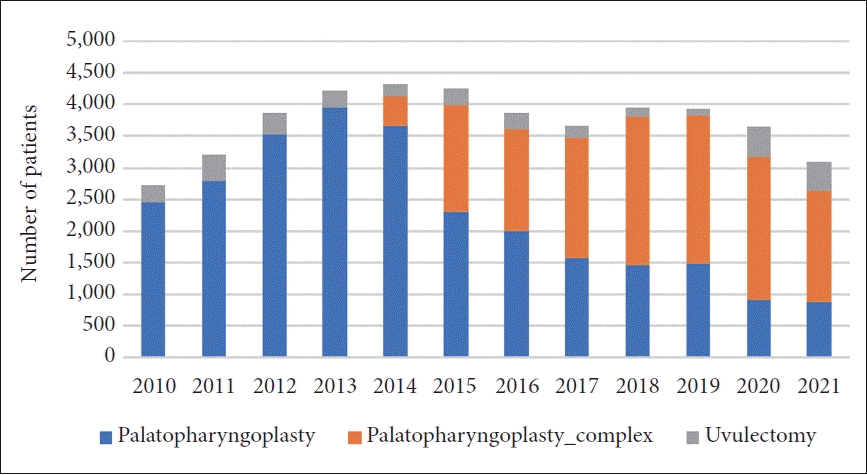
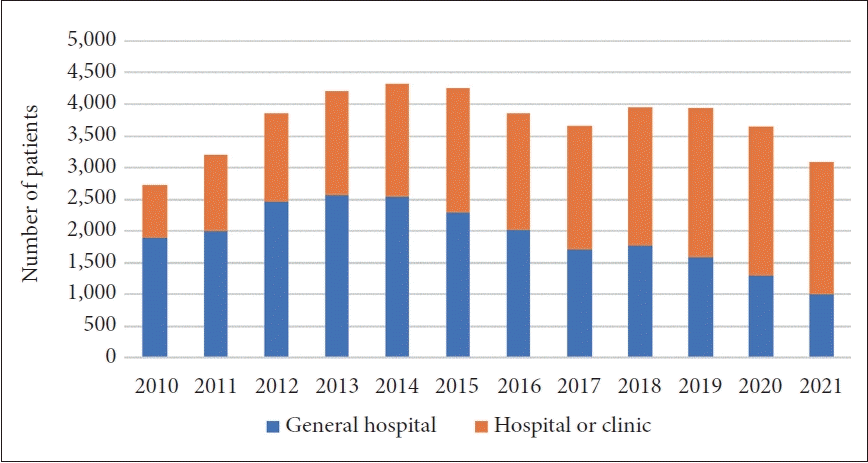
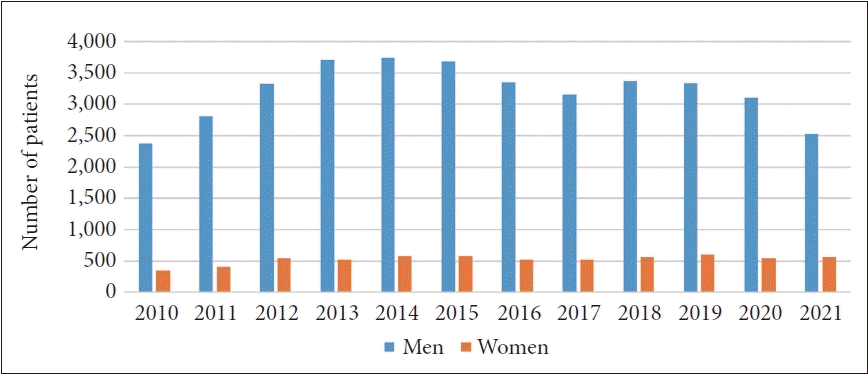
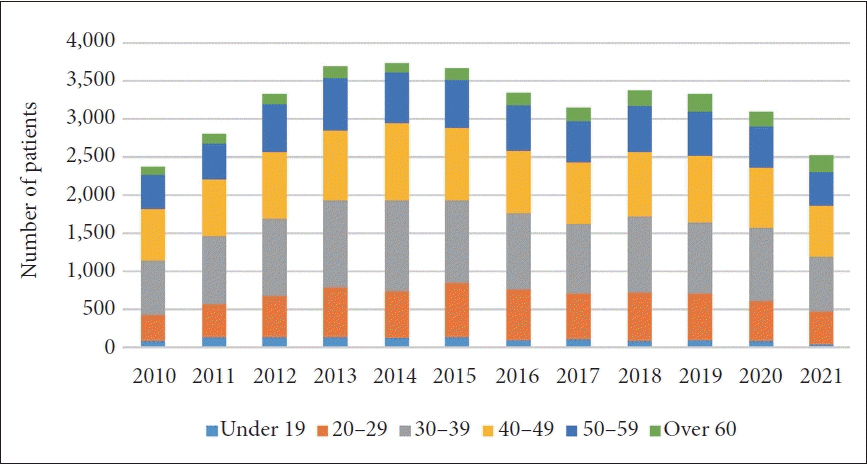
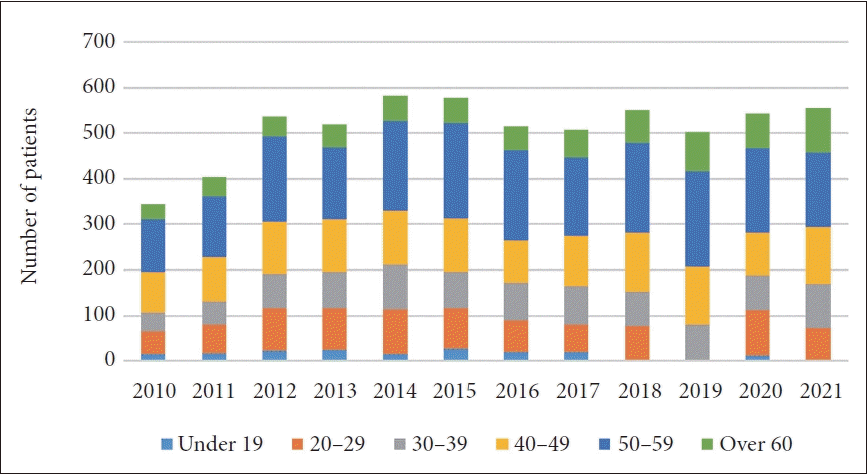
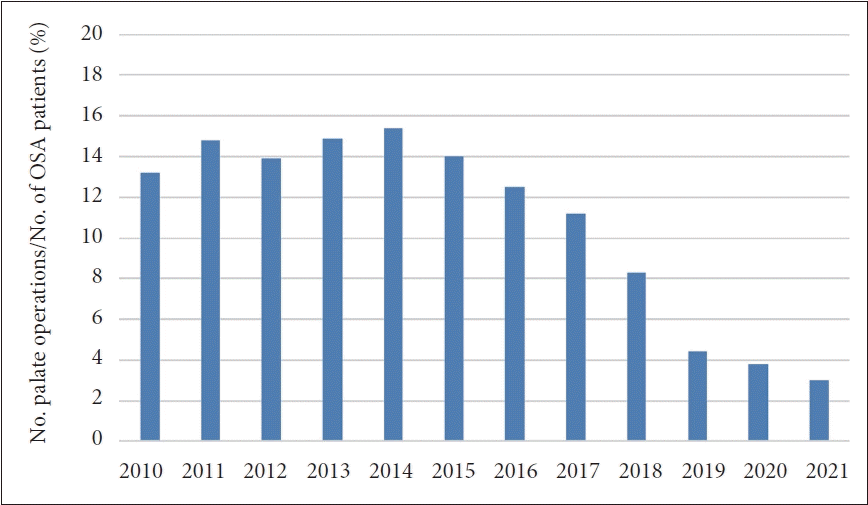
 XML Download
XML Download